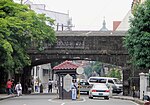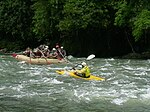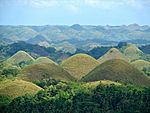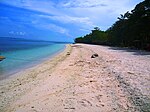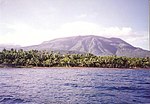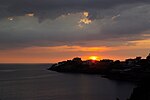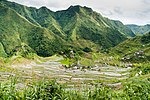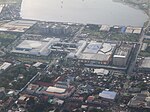List of tourist attractions in the Philippines
Appearance
Popular tourist attractions in the Philippines include the following:
Amusement, national and natural parks, and monuments
[edit]- Color Key
| Name | Image | City/Municipality | Province | Region | Notes |
|---|---|---|---|---|---|
| Bataan National Park | 
|
Bataan | Central Luzon | ||
| Biak-na-Bato National Park | 
|
Bulacan | Central Luzon | ||
| Enchanted Kingdom[1] | 
|
Santa Rosa | Laguna | Calabarzon | |
| Kalbario-Patapat Natural Park | 
|
Ilocos Norte | Ilocos Region | The natural park was established on April 20, 2007, by Proclamation no. 1275 encompassing 3,800 hectares (9,400 acres) with a buffer zone of 1,937 hectares (4,790 acres). The park was created under the National Integrated Protected Areas System (NIPAS) of the Department of Environment and Natural Resources.[2] | |
| MacArthur Landing Memorial National Park[3] | Palo | Leyte | Eastern Visayas | It was declared a national park on July 12, 1977, through Letter of Instructions No. 572 signed by President Ferdinand Marcos.[4] | |
| Manila Ocean Park | 
|
Ermita, Manila | Metro Manila (National Capital Region) | ||
| Mayon Volcano National Park | 
|
Albay | Bicol Region | First protected as a National Park in 1938, it was reclassified as a Natural Park in the year 2000.[5] | |
| Mount Apo Natural Park | 
|
Declared a National Park by Manuel L. Quezon through Proclamations No. 59 on May 9, 1936, and No. 35 on May 8, 1966[6] | |||
| Mounts Iglit-Baco National Park | 
|
Occidental Mindoro | Mimaropa | A protected sanctuary and home to the Tamaraws endemic to the island of Mindoro. Established as a National Park on November 9, 1970, by virtue of Republic Act No. 6148.[7] Listed by ASEAN as one of the nine heritage parks in the Philippines in 2003.[8] The park has also been nominated in the Tentative List of UNESCO World Heritage Sites.[9] | |
| Nagcarlan Underground Cemetery[10] | 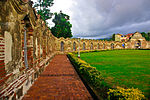
|
Nagcarlan | Laguna | Calabarzon | It is dubbed as the only underground cemetery in the country.[11] |
| Paco Park | 
|
Paco, Manila | Metro Manila (National Capital Region) | It was once Manila's municipal cemetery built by the Dominicans. Dr. Jose Protacio Rizal, Philippine National Hero, was secretly interred at Paco Park after his execution at Bagumbayan on December 30, 1896, and was guarded for fifteen days by the Guardia Civil Veterana. His remains were exhumed on August 17, 1898, and on December 30, 1912, was laid underneath the monument dedicated to him at the Luneta as stated in the Park's marker.[12][13] | |
| Quezon Memorial Circle[14] | Quezon City | Metro Manila (National Capital Region) | Its main feature is a tall mausoleum containing the remains of Manuel L. Quezon, the second official President of the Philippines and the first of an internationally recognized independent Philippines, and his wife, First Lady Aurora Quezon.[15] | ||
| Rizal Park[16] | 
|
Roxas Boulevard, Manila | Metro Manila (National Capital Region) | The park was a tribute to the Philippine's national hero, Jose Rizal, a doctor and novelist who was shot by firing squad at this site on December 30, 1896.[17] | |
| Salinas Natural Monument | 
|
Nueva Vizcaya | Central Luzon | The park was established on May 18, 1914, as the Salinas Forest Reserve covering the Salinas Salt Springs and surrounding forest through Executive Order No. 44 signed by Governor-General Francis Burton Harrison. It was finally declared a natural monument in 2000 under the National Integrated Protected Areas System through Proclamation No. 275 by President Joseph Estrada.[18][19] | |
| Star City | 
|
CCP Complex, Pasay | Metro Manila (National Capital Region) | ||
Churches
[edit]- Color Key
| Name | Image | City/Municipality | Province | Region | Notes |
|---|---|---|---|---|---|
| Antipolo Cathedral | 
|
Antipolo | Rizal | Calabarzon | On January 14, 1954, the Catholic Bishops Conference of the Philippines declared the new Antipolo Church as declared the National Shrine to Our Lady of Peace and Good Voyage. The church was elevated to the status of cathedral on June 25, 1983, upon the canonical erection of the Diocese of Antipolo.[20] |
| Baclaran Church | 
|
Baclaran, Parañaque | Metro Manila (National Capital Region) | Since the Feast of the Immaculate Conception 1958, the shrine has been authorised by the Holy See to remain open 24 hours a day throughout the entire year. The shrine itself was blessed by Pope John Paul II during his first Apostolic Visit to Metro Manila in 1981.[21] | |
| Baclayon Church[22] | 
|
Baclayon | Bohol | Central Visayas | It was severely damaged when a 7.2 magnitude earthquake struck Bohol and other parts of Central Visayas on October 15, 2013.[23] |
| Baguio Cathedral | 
|
Baguio | Benguet | Cordillera Administrative Region | The site where the cathedral currently stands was a hill referred to as Kampo by the Ibaloi people. In 1907, a Catholic mission was established at the site by Belgian missionaries from the Congregatio Immaculati Cordis Mariae, which they later called Mount Mary.[24] |
| Barasoain Church[25] | 
|
Malolos | Bulacan | Central Luzon | Site of the First Philippine Republic.[26] |
| Basilica del Santo Niño | 
|
Cebu City | Cebu | Central Visayas | In 1965, during the 4th centenary of the Christianization of the Philippines, Pope Paul VI elevated the church to the rank of minor basilica.[27] On October 15, 2013, the bell tower of the church was destroyed when a 7.2 magnitude earthquake struck Bohol and other parts of Central Visayas.[23] |
| Basilica Minore of Our Lady of Charity | 
|
Agoo | La Union | Ilocos Region | On July 15, 1982, Pope John Paul II gave due course to the petition of Bishop Salvador Lazo of the Diocese of San Fernando, La Union that the Shrine of Our Lady of Charity be endowed with the title of a Minor Basilica.[28] |
| Basilica of Our Lady of Piat[29] | 
|
Piat | Cagayan | Cagayan Valley | On June 22, 1989, it was made into a minor basilica by Pope John Paul II.[30][31][32] |
| Basilica of Saint Martin of Tours | 
|
Taal | Batangas | Calabarzon | Asia's largest Catholic church.[33] On December 8, 1954, the church was elevated into a minor basilica by Pope Pius XII.[34] |
| Binondo Church | 
|
Binondo, Manila | Metro Manila (National Capital Region) | In 1956, the church was made into a minor basilica by Pope Pius XII.[35] | |
| Cagayan de Oro Cathedral | 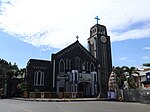
|
Cagayan de Oro | Misamis Oriental | Northern Mindanao | During its early history, it was believed that the first church structure built in present-day Cagayan de Oro (formerly Cagayan de Misamis) was erected in 1624 by the Augustinian Recollects under the leadership of Father Agustin de San Pedro.[36] |
| Cathedral of Praise | 
|
Manila | Metro Manila (National Capital Region) | ||
| Central United Methodist Church | 
|
Ermita, Manila | Metro Manila (National Capital Region) | Founded on March 5, 1899, during the American Occupation, it was originally named Central Methodist Episcopal Church. The church was originally designed by Juan Arellano.[37] | |
| Church of the Gesù | Quezon City | Metro Manila (National Capital Region) | |||
| Cosmopolitan Church | 
|
Ermita, Manila | Metro Manila (National Capital Region) | ||
| Ermita Church | 
|
Ermita, Manila | Metro Manila (National Capital Region) | The church is home to the Marian image of Our Lady of Guidance, which is considered to be the oldest Marian image in the Philippines, and in whose honor the church is officially named after and dedicated to.[38] | |
| Iglesia Evangelica Metodista en las Islas Filipinas | 
|
Manila | Metro Manila (National Capital Region) | ||
| Iglesia ni Cristo Central Temple[39] | Quezon City | Metro Manila (National Capital Region) | |||
| Imus Cathedral[40] | 
|
Imus | Cavite | Calabarzon | The cathedral was declared a structure of historical significance with the placing of a historical marker by then National Historical Institute of the Philippines on November 13, 2006.[41] |
| Jaro Cathedral | 
|
Jaro, Iloilo City | Iloilo | Western Visayas | The Catholic Bishops' Conference of the Philippines formally declared the cathedral the National Shrine of Our Lady of the Candles (Nuestra Señora de la Candelaria) in February 2012.[42] |
| Las Piñas Church | 
|
Las Piñas | Metro Manila (National Capital Region) | The church is home to the famous Bamboo Organ.[43] | |
| Loboc Church | 
|
Loboc | Bohol | Central Visayas | It was severely damaged when a 7.2 magnitude earthquake struck Bohol and other parts of Central Visayas on October 15, 2013.[23] |
| Loon Church | 
|
Loon | Bohol | Central Visayas | It was severely damaged when a 7.2 magnitude earthquake struck Bohol and other parts of Central Visayas on October 15, 2013.[23] |
| Malate Church | 
|
Malate, Manila | Metro Manila (National Capital Region) | The church is dedicated to Nuestra Señora de los Remedios ("Our Lady of Remedies"), the patroness of childbirth.[44] | |
| Malolos Cathedral[25] | 
|
Malolos | Bulacan | Central Luzon | On December 4, 1999, it was elevated into a minor basilica by Pope John Paul II.[45] |
| Manila Cathedral[16] | 
|
Intramuros, Manila | Metro Manila (National Capital Region) | On April 27, 1981, Pope John Paul II issued papal bull Quod Ipsum designating the cathedral as a minor basilica by his own Motu Proprio.[46][47] | |
| Maribojoc Church | 
|
Maribojoc | Bohol | Central Visayas | It was severely damaged when a 7.2 magnitude earthquake struck Bohol and other parts of Central Visayas on October 15, 2013.[23] |
| Miagao Church | 
|
Miagao | Iloilo | Western Visayas | The church was declared as a UNESCO World Heritage Site on December 11, 1993, under the collective title Baroque Churches of the Philippines, a collection of four Baroque Spanish-era churches.[48] |
| Minor Basilica of the Immaculate Conception | 
|
Batangas City | Batangas | Calabarzon | On February 13, 1945, the church was declared a Minor Basilica of the Immaculate Conception by Pope Pius XII.[49] |
| Minor Basilica of Our Lady of the Most Holy Rosary of Manaoag[50] | 
|
Manaoag | Pangasinan | Ilocos Region | In February 2015, the Shrine of Our Lady of The Rosary of Manaoag was elevated to a minor basilica by Pope Francis.[51] |
| Naga Cathedral[52] | 
|
Naga | Camarines Sur | Bicol Region | The first cathedral built for Naga was founded after the Diocese of Cáceres was established in 1595. It is a suffragan of the Diocese of Manila created by the papal bull of August 14, 1595, which also elevated the Diocese of Manila into an archdiocese. The church was destroyed by fire in 1768.[53] |
| Nuestra Señora de Gracia Church | 
|
Makati | Metro Manila (National Capital Region) | ||
| Our Lady of Montserrat Abbey | 
|
Mendiola, Manila | Metro Manila (National Capital Region) | ||
| Our Lady of the Abandoned Parish Church | 
|
Marikina | Metro Manila (National Capital Region) | ||
| Nagcarlan Church | 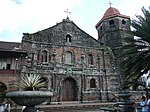
|
Nagcarlan | Laguna | Calabarzon | The church is famous for its Underground Cemetery which was built in 1845.[54] |
| Paoay Church[55] | 
|
Paoay | Ilocos Norte | Ilocos Region | It is declared as a National Cultural Treasure by the Philippine government in 1973 and a UNESCO World Heritage Site under the collective group of Baroque Churches of the Philippines in 1993.[48] |
| Parañaque Cathedral | 
|
Parañaque | Metro Manila (National Capital Region) | ||
| Parish of the Holy Sacrifice[39] | Quezon City | Metro Manila (National Capital Region) | |||
| Pasig Cathedral | 
|
Pasig | Metro Manila (National Capital Region) | ||
| Peñafrancia Basilica[52] | 
|
Naga | Camarines Sur | Bicol Region | On May 22, 1985, the church was consecrated into a minor basilica Pope John Paul II.[56] |
| Philippine Independent Church (Parish of La Purisima Concepcion de Malabon) |

|
Malabon | Metro Manila (National Capital Region) | ||
| Pinaglabanan Church | 
|
San Juan | Metro Manila (National Capital Region) | ||
| Quiapo Church[16] | 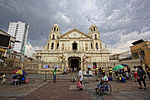
|
Quiapo, Manila | Metro Manila (National Capital Region) | On 1988, the church was made Basilica by Pope John Paul II thru the initiative of Cardinal Jaime Sin and Papal Nuncio Bruno Torpigliani.[57] | |
| Saint James the Apostle Parish Church | 
|
Paete | Laguna | Calabarzon | The church is known for its huge and exquisite collection of images depicting the Passion of Christ, its century-old paintings and wooden images of saints.[58] |
| Sampaloc Church | 
|
Sampaloc, Manila | Metro Manila (National Capital Region) | ||
| San Agustin Church[16] | 
|
Intramuros, Manila | Metro Manila (National Capital Region) | In 1993, San Agustin Church was one of four Philippine churches constructed during the Spanish colonial period to be designated as a World Heritage Site by UNESCO, under the collective title Baroque Churches of the Philippines.[48] | |
| San Bartolome Church | 
|
Malabon | Metro Manila (National Capital Region) | ||
| San Fernando de Dilao Church | 
|
Paco, Manila | Metro Manila (National Capital Region) | On February 7, 2012, the church was designated as pro-cathedral of the Archdiocese of Manila until structural renovations on the Cathedral-Basilica of the Immaculate Conception were completed on April 9, 2014.[59] | |
| San Miguel Church | 
|
San Miguel, Manila | Metro Manila (National Capital Region) | ||
| San Pedro Macati Church | 
|
Makati | Metro Manila (National Capital Region) | ||
| San Sebastian Cathedral | 
|
Bacolod | Negros Occidental | Western Visayas | |
| San Sebastian Church | 
|
Quiapo, Manila | Metro Manila (National Capital Region) | Only prefabricated steel church in the world.[60] Only all-steel temple in Asia,[61][62] On June 24, 1980, it was elevated into a minor basilica by Pope John Paul II.[63] | |
| Santa Cruz Church | 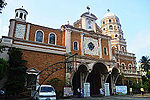
|
Manila | Metro Manila (National Capital Region) | ||
| Santa Maria Church | 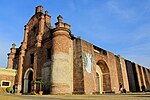
|
Santa Maria | Ilocos Sur | Ilocos Region | The church was designated as a UNESCO World Heritage Site on December 11, 1993, as part of the Baroque Churches of the Philippines, a collection of four Baroque Spanish-era churches.[48][64] |
| Santo Domingo Church[39] | 
|
Quezon Avenue, Quezon City | Metro Manila (National Capital Region) | On October 4, 2012, it was declared as a National Culture Treasure through Republic Act No. 4846, otherwise known as the Cultural Properties Preservation and Protection Act making it as the first national culture treasure in Quezon City.[65] | |
| Santuario del Santo Cristo | 
|
San Juan | Metro Manila (National Capital Region) | ||
| St. Anthony Shrine | 
|
Sampaloc, Manila | Metro Manila (National Capital Region) | ||
| Tayabas Basilica | 
|
Tayabas | Quezon | Calabarzon | Largest Catholic church in Quezon.[66] On October 18, 1988, the title Minor Basilica was conferred upon the church by Pope John Paul II and the Congregation for Divine Cult.[67] |
| Tondo Church | 
|
Tondo, Manila | Metro Manila (National Capital Region) | ||
Cultural and historical landmarks
[edit]- Color Key
Natural landmarks
[edit]- Color Key
Urban architecture landmarks
[edit]- Color Key
See also
[edit]- List of museums in the Philippines
- List of airports in the Philippines
- List of ports in the Philippines
- Tourism in the Philippines
Notes and references
[edit]- ^ a b c "Must See Attractions". Provincial Government of Laguna. Archived from the original on June 25, 2008. Retrieved July 8, 2023.
- ^ "PROTECTED AREAS IN REGION 1". Biodiversity Management Bureau.
- ^ "Historical Destinations". The Official Website of the Province of Leyte. Archived from the original on July 18, 2003. Retrieved July 8, 2023.
- ^ "LETTER OF INSTRUCTIONS NO. 572". Chan Robles Virtual Law Library.
- ^ "Protected Areas in Region 5". Biodiversity Management Bureau.
- ^ "Proclamation No. 35; Revoking Proclamation No. 507 — A dated December 16, 1965, which Excluded Certain Portions of Land from the Mt. Apo National Park and Restoring the Same Areas as Part of the Mt. Apo National Park". Official Gazette of the Republic of the Philippines. May 8, 1966. Retrieved July 24, 2019.
- ^ "Republic Act No. 6148 — An Act Declaring Mount Iglit, Mount Baco and the Adjoining Areas Situated in Sablayan, Occidental Mindoro and Bongabon, Oriental Mindoro as a National Park, Authorizing the Appropriation of Funds Necessary for the Development Thereof and For Other Purposes". Chan Robles Virtual Law Library. Retrieved July 24, 2019.
- ^ "ASEAN Heritage Parks". Association of Southeast Asian Nations. Retrieved July 25, 2019.
- ^ "Mt. Iglit-Baco National Park". UNESCO World Heritage Centre. Retrieved July 25, 2019.
- ^ a b "Must See Attractions". Provincial Government of Laguna. Archived from the original on June 25, 2008. Retrieved July 8, 2023.
- ^ "Visiting RP's only underground cemetery". Philippine Daily Inquirer. Archived from the original on October 18, 2014.
- ^ "Paco Park". National Parks development Committee. Archived from the original on December 19, 2013. Retrieved June 28, 2015.
- ^ "Paco Park: Where history lies with the dead". Vera Filles. October 31, 2014. Archived from the original on June 30, 2015. Retrieved June 28, 2015.
- ^ a b c d "Visitors; Must See QC". Quezon City Government Official Website. The Local Government of Quezon City. Archived from the original on June 10, 2007. Retrieved July 12, 2023.
- ^ "THE CIRCLE OF SUCCESS: QUEZON MEMORIAL CIRCLE". circleofsuccessqmc. June 26, 2011.
- ^ a b c d e f g "Places To Visit". Official Website of the City of Manila. Archived from the original on March 27, 2012. Retrieved July 8, 2023.
- ^ "Rizal Park". manila.ph.
- ^ "Region 2 – Protected Areas". Biodiversity Management Bureau.
- ^ "PROCLAMATION NO. 275 DECLARING THE SALINAS FOREST RESERVE AND DEER REFUGE SITUATED IN THE MUNICIPALITIES OF BAMBANG, KAYAPA AND ARITAO, PROVINCE OF NUEVA VIZCAYA, ISLAND OF LUZON AS PROTECTED AREA PURSUANT TO REPUBLIC ACT 7586 (NIPAS ACT OF 1992) AND SHALL BE KNOWN AS SALINAS NATURAL MONUMENT" (PDF). DENR. Archived from the original (PDF) on October 25, 2014. Retrieved June 28, 2015.
- ^ "National Shrine of Our Lady of Peace and Good Voyage". healthypinoy.com.
- ^ "National Shrine of Our Mother of Perpetual Help". healthypinoy.com.
- ^ a b c "SightseeingBohol!". Bohol Tourism: The Official Tourism Website of the Province of Bohol. Archived from the original on December 4, 2016. Retrieved July 8, 2023.
- ^ a b c d e Kim Luces (October 15, 2013). "From treasure to rubble: Heritage churches before and after the Bohol quake". GMA News and Public Affairs.
- ^ "Baguio Catholic Cathedral". cityofpines.com.
- ^ a b "Religious Tourist Attractions". Provincial Government of Bulacan. Archived from the original on March 16, 2011. Retrieved July 8, 2023.
- ^ "History of Barasoain Church". Barasoain Church.
- ^ "RADIO MESSAGE OF PAUL VI ON THE FOURTH CENTENARY OF THE EVANGELIZATION OF THE PHILIPPINES". Vatican. May 2, 1965.
- ^ "Basilica of Our Lady of Charity". healthpinoy.com.
- ^ "Tourism". Provincial Government of Cagayan. Archived from the original on March 6, 2016. Retrieved July 8, 2023.
- ^ Estanislao Caldez (June 15, 1999). "Piat Shrine: From lowly sanctuary to basilica". cagayano.tripod.com.
- ^ "Basilica of Our Lady of Piat". healthpinoy.com.
- ^ "Trivias about the Our Lady of Piat". philippine-trivia.com. Archived from the original on December 4, 2013. Retrieved June 28, 2015.
- ^ "TAAL BASILICA, BATANGAS: Asia's Largest Catholic Church". The Poor Traveler. April 29, 2012.
- ^ "Taal Basilica (San Martin de Tours)". pamana.com.
- ^ "MINOR BASILICA OF SAN LORENZO RUIZ IN BINONDO, MANILA". churchspottingandbeyond.
- ^ Demetrio (Ed.), Francisco R. (1995). The Local Historical Sources of Northern Mindanao – Volume 1 (First ed.). Cagayan de Oro, Philippines: Xavier University. pp. 428–486. ISBN 9719094001.
- ^ "Heritage Conservation Society". January 2, 2007. Retrieved March 8, 2015.
- ^ "About Ermita Church". Ermita Church. Archdiocesan Shrine of Nuestra Señora de Guia.
- ^ a b c "Historical Places of Worship". The Local Government of Quezon City. Archived from the original on May 14, 2012. Retrieved July 8, 2023.
- ^ a b c "Historical Sites". The Official Website of the Provincial Government of Cavite. Archived from the original on November 9, 2016. Retrieved July 8, 2023.
- ^ "The Imus Cathedral (Our Lady Of The Pillar Parish)". bluedreamer27.com. April 15, 2015.
- ^ "Nat'l shrine declaration for Jaro cathedral". Philippine Daily Inquirer. January 30, 2012.
- ^ "Simbahan ng Las Piñas]". National Registry of Historic Sites and Structures in the Philippines. April 21, 2013.
- ^ "Philippines Travel Guide: Malate Church". Yahoo Travel. July 7, 2008.
- ^ "Minor Basilica of the Immaculate Conception". healthpinoy.com.
- ^ "IOANNES PAULUS PP. II LITTERAE APOSTOLICAE QUOD IPSUM AEDES MANILENSIS ARCHIDIOECESIS PRINCEPS BEATAE VIRGINIS MARIAE SACRA SUB TITULO IMMACULATAE CONCEPTIONIS AD HONOREM ATTOLLITUR BASILICAEQUE DIGNITATEM MINORIS". Vatican.
- ^ "The Basilica of the Immaculate Conception (The Manila Cathedral)". healthpinoy.com.
- ^ a b c d "Baroque Churches of the Philippines". UNESCO.
- ^ "Basilica of the Immaculate Concepcion, Batangas City". Wow Batangas. June 19, 2009.
- ^ a b c "Pangasinan Tourist Attractions" (PDF). Provincial Government of Pangasinan. Provincial Tourism and Cultural Affairs Office. February 11, 2015. Archived from the original (PDF) on November 23, 2018. Retrieved July 8, 2023.
- ^ "Manaoag Shrine elevated to Basilica". manaoagshrine.org.
- ^ a b "Churches". The Official Website of the Provincial Government of Camarines Sur. Archived from the original on March 12, 2009. Retrieved July 8, 2023.
- ^ "Cathedral of Naga". National Registry of Historic Sites and Structures in the Philippines.
- ^ "The Nagcarlan Churich and The Underground Cemetery". nagcarlanlaguna.info. Archived from the original on February 5, 2016. Retrieved January 21, 2016.
- ^ a b c "Travel Guide; Highlights". Provincial Government of Ilocos Norte. Archived from the original on February 9, 2003. Retrieved July 12, 2023.
- ^ "Peñafrancia Basilica Minore and National Shrine". healthpinoy.com.
- ^ "History of Quiapo Church". quiapochurch.com. Archived from the original on June 30, 2015. Retrieved June 28, 2015.
- ^ "Paete Church: St. James the Apostle Parish". Laguna-Destinations.
- ^ "Pro-Cathedral Church of San Fernando de Dilao..(Paco Church)". Blogspot. Archived from the original on February 14, 2016. Retrieved January 21, 2016.
- ^ Francis Doral, ed. (2005). Insight Guides: Philippines. Singapore: Discovery Channel & APA Publications GmbH & Co. Verlag KG. p. 152.
Near where Recto avenue becomes Mendiola Street is San Sebastian Church, reputedly the only prefabricated steel church in the world.
- ^ "World Heritage: San Sebastian Church". Tentative List for the World Heritage List. UNESCO. Retrieved April 20, 2008.
- ^ Layug, p. 88. "The basilica is the first and the only all-steel church in Asia, the second in the world after the Eiffel Tower of Paris (French engineer Alexandre Gustave Eiffel himself is also rumored to have been involved in the basilica's construction) "
- ^ "Basilica of San Sebastian". healthpinoy.com.
- ^ Jane Dacumos (August 3, 2012). "The Nuestra Señora de la Asuncion – Ilocos Sur". vigattintourism.com.
- ^ Gracelyn A. Simon (November 10, 2012). "Sto. Domingo Church declared nat'l treasure". The Varsitarian. Archived from the original on September 7, 2014. Retrieved June 28, 2015.
- ^ "Getting Married in Quezon: Walk in the Aisle of Tayabas Church". Wow Quezon. August 16, 2012.
- ^ "Ang Sambayanang Kristiyano ng Basilica Menor ni San Miguel Arkanghel". tayabasbasilica.org. September 16, 2014.
- ^ Nelles Verlag (February 2001). Philippines. ISBN 9783886182220.
- ^ Chelsea Dauz (April 23, 2014). "Binondo: The world's oldest chinatown". When in Manila.
- ^ Torres, Jose Victor. "The Iberian Social Club". Metrozines: Metro Society. Metro Society. Retrieved May 25, 2014.
- ^ "Shrines and Monuments". The Local Government of Quezon City. Archived from the original on May 14, 2012. Retrieved July 8, 2023.
- ^ "The Story of EDSA Shrine". edsashrine.com. March 11, 2013.
- ^ "Vigan named as one of the New7Wonders". Editorial in Manila.
- ^ Journal of American Folklore. American Folk-lore Society. 1904.
- ^ Manila Merchants' Association (1908). Manila, the Pearl of the Orient: Guide Book to the Intending Visitor. Bureau of printing. p. 30.
- ^ a b c "Cultural Heritage". The Official Website of the Cebu Provincial Government. Archived from the original on May 11, 2003. Retrieved July 8, 2023.
- ^ Norbert Bermosa. "Interesting Facts About the Malacañan Palace: Official Residence of the Philippine President". knoji.com.
- ^ "Resolution No. 2, s. 1991. Declaring the Army and Navy Club Building on South Boulevard, Manila a National Historical Landmark" (PDF). National Historical Commission of the Philippines. Archived from the original (PDF) on October 18, 2014. Retrieved October 15, 2014.
- ^ de la Torre, Visitacion (1981). Landmarks of Manila: 1571–1930. Makati: Filipinas Foundation, Inc. pp. 19–20.
- ^ Montinola, Lourdes (2010). Art Deco in the Philippines. Manila: ArtPositAsia. ISBN 978-971-057-905-1.
- ^ Ocampo, Ambeth (November 11, 2008). "Looking Back: A personal introduction". Philippine Daily Inquirer. Archived from the original on August 1, 2013.
- ^ "The Idyllic Ancestral Home of the Mercados in Calamba". traveleronfoot.
- ^ a b c d "Tourist Destination". Official Website of the Province of Negros Oriental. Archived from the original on November 4, 2011. Retrieved July 8, 2023.
- ^ Ronnel Domingo (June 22, 2009). "2 RP sites make it to 'must dive' list". Global Nation. Archived from the original on January 31, 2009.
- ^ "Tourism". The Official Website of Occidental Mindoro. Archived from the original on May 21, 2022. Retrieved July 8, 2023.
- ^ "Apo Reef Natural park". UNESCO.
- ^ "Banaue Rice Terraces: Facts and Figures". Philippine Statistics Authority. Archived from the original on November 13, 2012.
- ^ Jojo Malig (July 9, 2012). "Boracay named 2012 world's best island". ABS-CBN News and Current Affairs.
- ^ "BORACAY named 2012 No.1 World's Best Island". Boracay Live. July 16, 2012.
- ^ "Coron Island Natural Biotic Area". World Heritage Centre: Tentative lists. UNESCO. Retrieved February 16, 2016.
- ^ Candice Lopez-Quimpo (February 13, 2014). "The Philippines' best beaches and islands". CNN.
- ^ "El Nido named best Philippine beach". ABS-CBN News and Current Affairs. May 30, 2012.
- ^ a b c d e f Norbert Bermosa. "Top Ten Most Active Volcanoes in the Philippines". knoji.com.
- ^ "Natural Destinations". The Official Website of the Province of Leyte. Archived from the original on July 18, 2003. Retrieved July 8, 2023.
- ^ a b "Scenic Spots". The Official Website of the City Government of Iligan. Archived from the original on March 16, 2019. Retrieved July 8, 2023.
- ^ "Experience Albay's Tourists Attractions". Province of Albay. Archived from the original on February 6, 2007. Retrieved July 8, 2023.
- ^ "Top 10 Stunning Volcanoes Around the World". Places to See in Your Lifetime.
- ^ "The highest mountains in the Philippines". Pinoy Mountaineers. February 2, 2008.
- ^ "Mount Apo in Davao – Philippines". Davao Board.
- ^ "Nine New Sites Inscribed on World Heritage List". UNESCO. June 23, 2014. Archived from the original on June 25, 2014. Retrieved June 23, 2014.
- ^ "Natural Wonders". The Official Website of the Provincial Government of Camarines Sur. Archived from the original on February 3, 2007. Retrieved July 8, 2023.
- ^ "25 Highest Mountains in the Philippines". Tagalog Lang.
- ^ "Pagudpud". Philippine Travel Destinations. Archived from the original on June 29, 2015. Retrieved June 27, 2015.
- ^ "Baies membres". January 10, 2024.
- ^ "It's official: PPUR is among world's new wonders of nature". ABS-CBN News and Current Affairs. January 28, 2012.
- ^ "Baies membres". January 10, 2024.
- ^ "Philippine Rice Terraces no longer in danger". ABS-CBN News and Current Affairs. June 26, 2012.
- ^ "Longest mountain range". Philippine Daily Inquirer. February 5, 2011. Archived from the original on February 9, 2011. Retrieved June 27, 2015.
- ^ Tina Lim. "A Lake Within A Volcano Within a Lake Within a Volcano". Afar.com.
- ^ "Places to See". Province of Camiguin Official Website. Archived from the original on June 11, 2011. Retrieved July 12, 2023.
- ^ "Its Beginnings". Asilo Manila. Asilo de San Vicente de Paul. Archived from the original on July 18, 2014. Retrieved May 21, 2014.
- ^ "Bangui Windmills". Ilocandia Realtor. Archived from the original on September 10, 2013. Retrieved June 27, 2015.
- ^ Morallos, Chando P. (1998). Treasures of the National Library: A Brief History of the Premier Library of the Philippines. Manila: Quiapo Printing. ISBN 971-556-018-0.
- ^ "SM to put up its 4th largest mall". Philippine Star. May 4, 2011.
- ^ a b c "SM Megamall now PH's largest mall". Philippine Daily Inquirer. January 28, 2014.
- ^ Germelina Lacorte (September 27, 2012). "Biggest mall in Mindanao opens in Davao City". Philippine Daily Inquirer.


















